Dan Bricklin's Web Site: www.bricklin.com
|
|
The Evolving Personal Computer
The PC has stayed relevant by evolving its components.
|
|
I was interviewed by PCWeek magazine for an "end of the millenium" Vision 2000 look at the PC (December 20/27 issue, page 66). I related to them my latest explanation of why the personal computer is a general purpose platform for computing. At that point, on the phone, I realized that the original IBM PC design has really evolved and is continuing to evolve and that this evolution is part of its strength and staying power. This essay looks into that a little further.
The early personal computers, such as the S-100 bus machines and the Apple II, borrowed from minicomputers the concept of using plug-in parts. When Apple wanted to add diskette drives to the Apple II, Woz just had to design one (elegant) board to plug in and all Apple IIs could upgrade to include disk storage. Serial and printer adapters were added the same way.
The IBM PC followed the Apple II design, including using plug-in cards for major features. Copying the Apple II, IBM thought that 64KB was enough memory since they could find few Apple IIs with more than that. This was based on market research without seeming to realize that the 6502 microprocessor in the Apple II could only address 64KB vs. the 640KB of the IBM PC's 8088-based design. (A true story: That's what they told us back then.) Luckily for IBM, Tecmar and others temporarily filled the gap with "add-in" boards with more memory so that products like Lotus 1-2-3 that needed more than 64KB could be developed.
Compaq Computer helped define what it meant to be an "IBM Compatible" when they released their first product. It had to run software unmodified, use the same add-in boards, have the same connectors, and have the same keyboard layout. The display adapter was improved, but upwards compatible.
Over time other peripherals became available. When a particular peripheral became popular, the PC manufacturers made it standard equipment, eventually integrated into the main design. Modems, higher resolution display adapters, CDROM drives, sound cards, speakers, and more were added.
In each case, older applications and devices were supported until they weren't important to purchasers. For example, for a few years you could buy computers with both 5 1/4" and 3 1/2" diskette drives and both size serial adapters were provided. Microsoft Windows didn't really catch on until it supported more memory and ran DOS programs at the same time.
The Apple Macintosh showed that a mouse and GUI were an important advance. The PC evolved, first by using an add-in mouse and add-in software, and later with the mouse standard and Windows preloaded. Apple products evolved, too, but with more quantum jumps.
PC laptops got expandability through PCMCIA cards. This proved that hardware interfaces other than the techie plug-in boards worked in the PC world. The Mac world had shown that a serial bus and the daisy-chained minicomputer SCSI system were also viable.
The internal plug-in boards have now evolved into the Universal Serial Bus (USB) system. You can add all sorts of devices, from cameras to disks to printers to scanners, all using one style of connector.
The PC has evolved from a simple machine for running Basic programs and character-based spreadsheets and business forms to a machine for viewing, manipulating, and sharing formatted text, images, sounds, and more.
As we find new uses for computing power, the PC will continue to evolve to stay a platform we can use for general purpose computing.
To drive home this point of the evolution, look at these pictures of the connections on an original IBM PC:
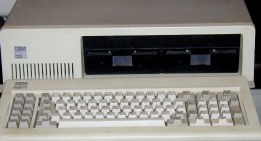  Compare those parts to the ones on a new Gateway Profile 2 PC:
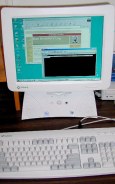 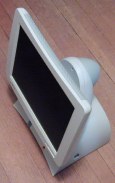 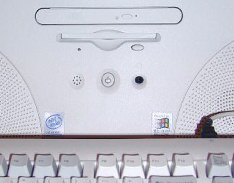 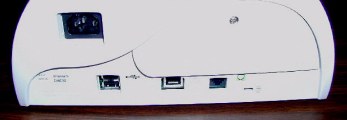 The screen is completely different (XGA color LCD vs. the old monochrome green character display), the keyboard is somewhat different, and the 5 1/4" floppies are replaced by a DVD drive and a 3 1/2" diskette. It adds integral speakers, microphone and sound card. The parallel printer adapter and serial ports (borrowed from minicomputers) have been replaced by USB ports. The keyboard is now USB and there is no extra game port. There is an RJ-11 (modem) and an RJ-45 (Ethernet) jack built in. It takes up much less space and has some nice curves.
The only connector these two machines still have in common is the power cord socket. The only "IBM PC specific" things are some funny keys like "PrtSc", and the fact that it can still run software like the original VisiCalc (shown on the screen in front of a browser with my log web site). Intel and Microsoft are still "inside", but quite evolved.
|
|
|
© Copyright 1999-2018 by Daniel Bricklin
All Rights Reserved.
|